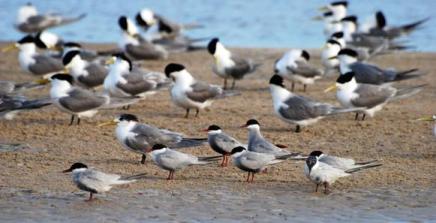Project Description
Sand Island Stopover Project: Restoring Noosa’s Shorebird Habitat
This project is funded by Healthy Land and Water (HLW) through the Australian Government National Landcare Program
September 2020. NICA, in partnership with Healthy Land & Water, is pleased to announce the “Sand Island Stopover” project. The 12 month project is intended to complete rehabilitation of the Sand Island and adjacent areas in the Noosa River estuary to preserve critical habitat for numerous threatened shorebird species, identified in NICA’s recent Shorebird survey report. NICA will also monitor shorebird response to rehabilitation efforts and raise awareness of the shorebirds presence and plight. The community is welcome to participate, contact admin@noosariver.com.au for details. #WeareNICA #NICA #HLW #Noosa River #Shorebirds

Press Release – Shorebirds of the Noosa River Report 2020
This project is funded by a Noosa Council Environmental grant.
August, 2020. Long running survey of Noosa’s threatened shorebirds highlights declines in abundance. A report on a long running survey of the Noosa River has documented the rich but threatened biodiversity and declining abundance of shorebirds frequenting the estuary.
Conducted by an experienced team of NICA volunteers over a 14-year period commencing in 2005, the survey aimed at understanding the diversity of shorebirds in the estuary, along with their abundance over the period. Prior to 2005 there was no such data available on these species.
President of NICA, Bruce Hallett said it was well established that waterbirds, and particularly shorebirds, provide an excellent and leading indicator of overall ecosystem health. “Though a relatively small estuary in comparison to nearby RAMSAR sites, the Noosa River really does punch above its weight in respect of shorebird biodiversity and previously abundance. It is critical we restore and preserve the estuary for these threatened shorebirds, particularly those migratory species that travel thousands of kilometres to the Noosa River each year”.
Over 275 surveys of the Noosa River estuary were conducted to understand both the diversity and abundance of shorebirds visiting the estuary. The report revealed that almost half (18) of the 37 species of migratory shorebirds that traverse the East-Asian Australasian Flyway from the Northern Hemisphere have frequented the estuary, though the abundance of these species has declined 45% over the period. In contrast, numbers of the 9 resident shorebird species have increased around 10%. Another 32 species of terns, gulls, water birds, wading birds, sea birds and raptors were also observed and recorded in the survey data.
“This is good and bad news” says Mr Hallett. “On the one hand, resident shorebird species are holding up, however migratory species, of which 7 are listed as threatened including 3 critically endangered, are unfortunately reflecting population declines witnessed elsewhere along the flyway due largely to loss of habitat. It is critical Noosa plays its part in preserving healthy and undisturbed habitat for these species along the flyway”.
Mr Hallett said the study was testament to what a community-led organisation like NICA could deliver to the community in terms of conservation and scientific endeavour in partnership with key stakeholders. “Noosa Council has been a wonderful partner for the diligent work of NICA’s dedicated shorebird volunteers over a long period of time. The assistance provided under the Community Environment Grants Program in compiling this report has been greatly appreciated”.
NICA is planning further shorebird conservation and awareness initiatives around the Noosa River in the near future and the community is welcome to participate.

